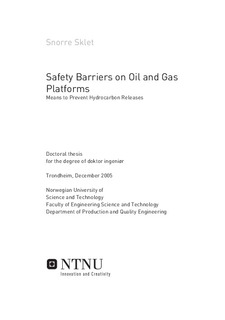| dc.contributor.author | Sklet, Snorre | nb_NO |
| dc.date.accessioned | 2014-12-19T12:25:59Z | |
| dc.date.available | 2014-12-19T12:25:59Z | |
| dc.date.created | 2007-07-23 | nb_NO |
| dc.date.issued | 2006 | nb_NO |
| dc.identifier | 122483 | nb_NO |
| dc.identifier.isbn | 82-471-7741-2 | nb_NO |
| dc.identifier.uri | http://hdl.handle.net/11250/241291 | |
| dc.description.abstract | The main objective of the PhD project has been to develop concepts and methods that can be used to define, illustrate, analyse, and improve safety barriers in the operational phase of offshore oil and gas production platforms.
The main contributions of this thesis are;
Clarification of the term safety barrier with respect to definitions, classification, and relevant attributes for analysis of barrier performance
Development and discussion of a representative set of hydrocarbon release scenarios
Development and testing of a new method, BORA-Release, for qualitative and quantitative risk analysis of hydrocarbon releases
Safety barriers are defined as physical and/or non-physical means planned to prevent, control, or mitigate undesired events or accidents. The means may range from a single technical unit or human actions, to a complex socio-technical system. It is useful to distinguish between barrier functions and barrier systems. Barrier functions describe the purpose of safety barriers or what the safety barriers shall do in order to prevent, control, or mitigate undesired events or accidents. Barrier systems describe how a barrier function is realized or executed. If the barrier system is functioning, the barrier function is performed. If a barrier function is performed successfully, it should have a direct and significant effect on the occurrence and/or consequences of an undesired event or accident.
It is recommended to address the following attributes to characterize the performance of safety barriers; a) functionality/effectiveness, b) reliability/availability, c) response time, d) robustness, and e) triggering event or condition. For some types of barriers, not all the attributes are relevant or necessary in order to describe the barrier performance.
The presented hydrocarbon release scenarios include initiating events, barrier functions introduced to prevent hydrocarbon releases, and barrier systems realizing the barrier functions. Both technical and human/operational safety barriers are considered. The initiating events are divided into five main categories; (1) human and operational errors, (2) technical failures, (3) process upsets, (4) external events, and (5) latent failures from design.
The development of the hydrocarbon release scenarios has generated new knowledge about causal factors of hydrocarbon releases and safety barriers introduced to prevent the releases. Collectively, the release scenarios cover the most frequent initiating events and the most important safety barriers introduced to prevent hydrocarbon releases.
BORA-Release is a new method for qualitative and quantitative risk analysis of the hydrocarbon release frequency on oil and gas platforms. BORA-Release combines use of barrier block diagrams/event trees, fault trees, and risk influence diagrams in order to analyse the risk of hydrocarbon release from a set of hydrocarbon release scenarios.
Use of BORA-Release makes it possible to analyse the effect on the hydrocarbon release frequency of safety barriers introduced to prevent hydrocarbon releases. Further, BORA-Release may be used to analyse the effect on the barrier performance of platform specific conditions of technical, human, operational, and organisational risk influencing factors. Thus, BORA-Release may improve today’s quantitative risk analyses on two weak points; i) analysis of causal factors of the initiating event hydrocarbon release (loss of containment), and ii) analysis of the effect on the risk of human and organisational factors.
The main focus of this thesis is safety barriers introduced to prevent hydrocarbon releases on offshore oil and gas production platforms. Thus, the results are primarily useful for the oil and gas industry in their effort to control and reduce the risk of hydrocarbon releases. The Norwegian oil and gas industry can use the results in their work to fulfil the requirements to safety barriers and risk analyses from the Petroleum Safety Authority. However, the concepts and methods may also be applied in other industries (e.g., the process industry) and application areas (e.g., the transport sector) in their effort to reduce the risk. | nb_NO |
| dc.language | eng | nb_NO |
| dc.publisher | Fakultet for ingeniørvitenskap og teknologi | nb_NO |
| dc.relation.ispartofseries | Doktoravhandlinger ved NTNU, 1503-8181; 2006:3 | nb_NO |
| dc.relation.haspart | Sklet, Snorre. Safety barriers: Definition, classification, and performance. Journal of Loss Prevention in the Process Industries. 19(5): 494-506, 2006. | nb_NO |
| dc.relation.haspart | Sklet, Snorre. Hydrocarbon releases on oil and gas production platforms: Release scenarios and safety barriers. Journal of Loss Prevention in the Process Industries. 19(5): 481-493, 2006. | nb_NO |
| dc.relation.haspart | Aven, Terje; Sklet, Snorre; Vinnem, Jan Erik. Barrier and operational risk analysis of hydrocarbon releases (BORA-Release). Journal of Hazardous Materials. 137(2): 681-691, 2006. | nb_NO |
| dc.relation.haspart | Sklet, Snorre; Vinnem, Jan Erik; Aven, Terje. Barrier and operational risk analysis of hydrocarbon releases (BORA-Release). Journal of Hazardous Materials. 137(2): 692-708, 2006. | nb_NO |
| dc.relation.haspart | Sklet, Snorre. Comparison of some selected methods for accident investigation. Journal of Hazardous Materials. 111: 29-37, 2004. | nb_NO |
| dc.relation.haspart | Sklet, Snorre; Steiro, Trygve; Tjelta, Odd. Qualitative Analysis of Human, Technical and Operational Barrier Elements during Well Interventions. . | nb_NO |
| dc.relation.haspart | Corneliussen, Kjell; Sklet, Snorre. Challenges related to surveillance of safety functions. . | nb_NO |
| dc.title | Safety Barriers on Oil and Gas Platforms. Means to Prevent Hydrocarbon Releases | nb_NO |
| dc.type | Doctoral thesis | nb_NO |
| dc.contributor.department | Norges teknisk-naturvitenskapelige universitet, Fakultet for ingeniørvitenskap og teknologi, Institutt for produktutvikling og materialer | nb_NO |
| dc.description.degree | dr.ing. | nb_NO |
| dc.description.degree | dr.ing. | en_GB |
